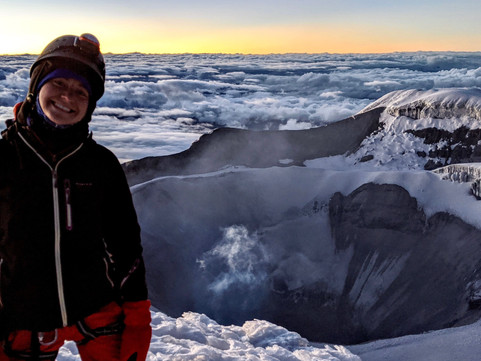Mountaineering in Ecuador
- Michelle Riband
- Jul 15, 2020
- 3 min read
Updated: Feb 15, 2022
After a restless night with only a couple hours of shut eye, I left the warmth of my sleeping bag to brave the sub-zero chill under a starry sky. My headlamp illuminated two meters in front of me as I snaked my way up the steep mountainside, one decisive step after another. It was silent, but for the howling wind and the rhythmic crunch of my crampons and ice axe as they gripped the hard snow.

My quads started to burn and I couldn’t feel my toes. I doubted why I was even doing this. I could have been on a beach, but, instead, in some weird masochistic twist, chose to spend my time and money on the brink of suffering. But there was something otherworldly about it. Under the blanket of night, you have a distorted sense of your progress—not really knowing where you are or how much farther you have to go. You just plow forward, willing yourself up the mountain. A test of your mental fortitude.
The oxygen thinned and the wind picked up. I thought about the story my Dad used to read me before bed; the one about the little train—"I think I can, I think I can." I thought about my grandfather who used to climb mountains in the Peruvian Andes sixty years ago in a collared shirt, wool sweater, and heavy leather boots. I had no excuse in my Gore-Tex pants and down parka. I thought about my faint headache and growling stomach. My body was running on Gatorade, chocolate, and sheer determination. The goal was clear. I kept pushing.
Finally, after six hours of steep ascent, I reached the summits.
From all the photos I saw in tourist brochures, I knew that climbing volcanoes in Ecuador would be beautiful. But I did not expect to be filled with so much gratitude and pride as I stumbled up the final meters to each mountaintop. Both peaks offered breathtaking rewards, unique in their own ways.
Cotopaxi (5,987m / 19,347ft), Ecuador’s highest active volcano and second highest mountain, gifted me a glorious sunrise with an orange glow above a sea of clouds. The crater steamed and four other snow-capped peaks towered majestically above the horizon, including Chimborazo—next week’s conquest. The summit buzzed with energy as climbers hugged and high fived, celebrating their victory. I reveled in the camaraderie, part of a supportive and boisterous team of six.

Chimborazo (6,268m / 20,564ft), Ecuador’s highest mountain, was a whole different story. At 5:10AM, I stood at the farthest point from the center of the earth—just me and my guide. Due to the equatorial bulge, I was technically higher than Everest. It didn't matter that my teeth were chattering and a dark cloud was descending with wisps of snow. Engulfed by the predawn darkness, I stared up at that sliver of the moon, beaming, closer to it than I will ever be. In the sheer vastness of my surroundings, I was a meaningless speck, but I felt unstoppable.

I am a novice mountaineer, but, after climbing various mountains in the US, Nepal, and now Ecuador, I can say that I get the allure. Atop snow-covered peaks, I have found a version of myself that is stronger and more capable than I ever could have imagined. Pushing through my physical and mental limits, I have redefined my own parameters of what is possible. So, while the mountains offer immense grandeur and beauty, they also provide the chance to reexamine who you are and what it means to confront new challenges. Surrounded by bright white towers basking in the early morning light, I finally understood the high of being high.












Comments